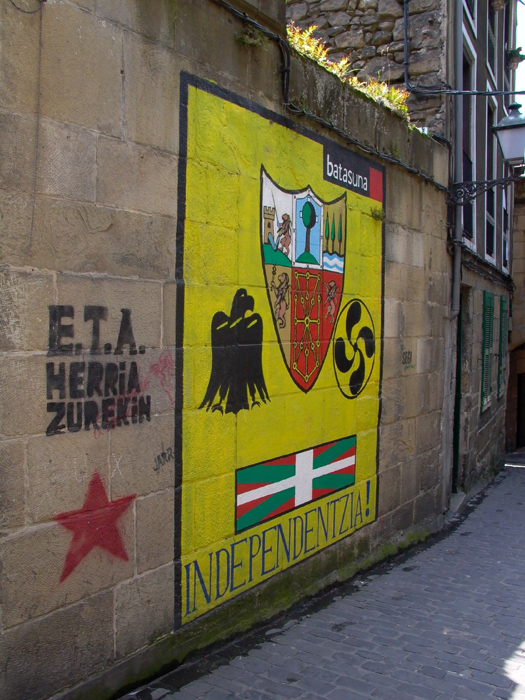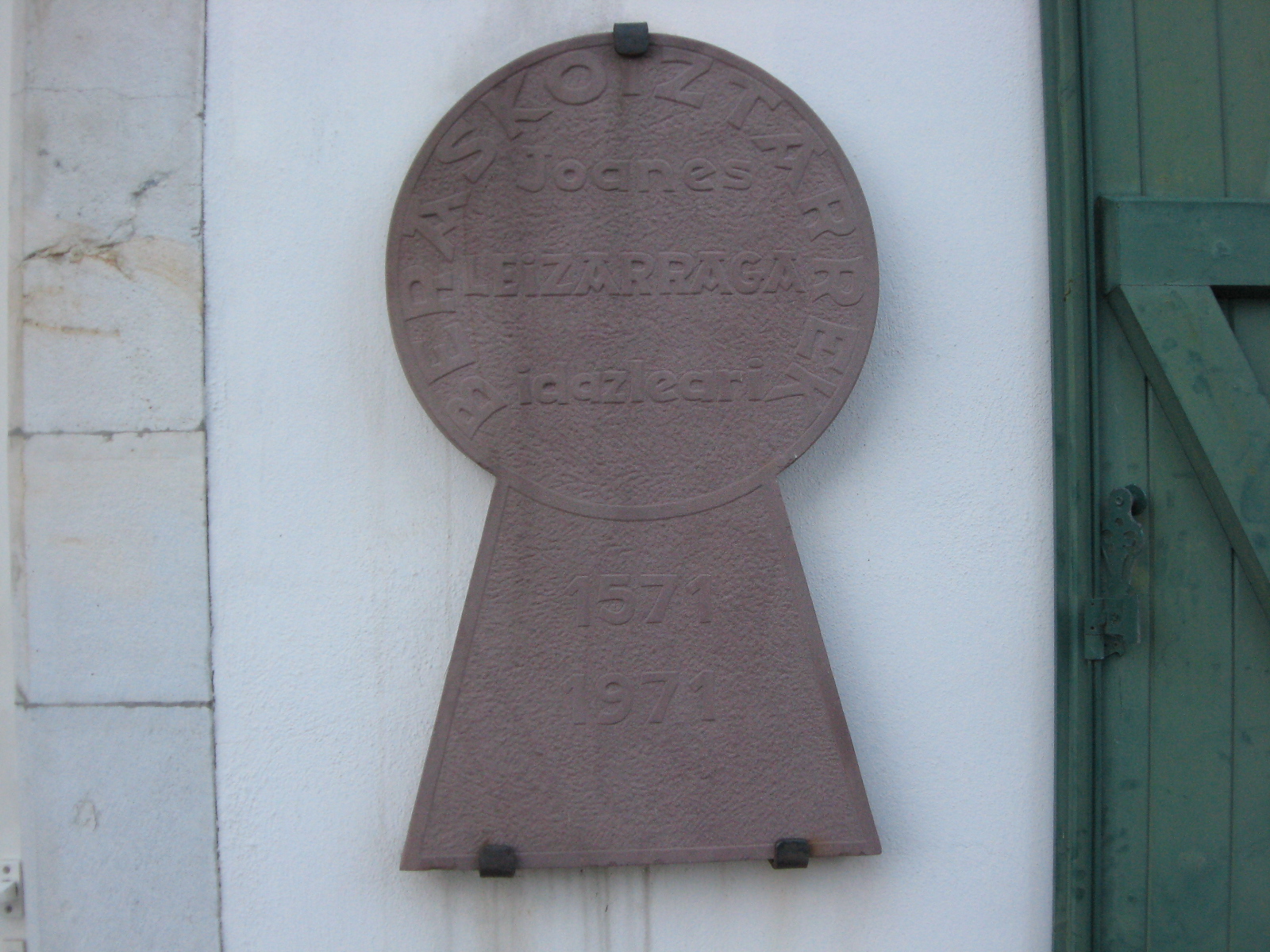|
Basque Country (greater Region)
The Basque Country ( eu, Euskal Herria; es, País Vasco; french: Pays basque) is the name given to the home of the Basque people. Trask, R.L. ''The History of Basque'' Routledge: 1997 The Basque country is located in the western Pyrenees, straddling the border between France and Spain on the coast of the Bay of Biscay. ''Euskal Herria'' is the oldest documented Basque name for the area they inhabit, dating from the 16th century. It comprises the Autonomous Communities of the Basque Country and Navarre in Spain and the Northern Basque Country in France. The region is home to the Basque people ( eu, Euskaldunak), their language ( eu, Euskara), culture and traditions. The area is neither linguistically nor culturally homogeneous, and certain areas have a majority of people who do not consider themselves Basque, such as the south of Navarre. The concept is still highly controversial, and the Supreme Court of Navarre has ruled against scholarly books that include the Navarre ... [...More Info...] [...Related Items...] OR: [Wikipedia] [Google] [Baidu] |
Zazpiak Bat
Zazpiak Bat is a heraldic nickname for the Basque coat of arms which includes the arms of the seven provinces mentioned, stressing their unity. It was designed by the historian Jean de Jaurgain in 1897 for the ''Congrès et Fêtes de la Tradition basque'' celebrated at Saint-Jean-de-Luz. Name ''Zazpiak Bat'' is a motto attributed to Basque people, Basque explorer Antoine-Thomson d'Abbadie in the late nineteenth century, from the Basque language, Basque words ''zazpiak'' meaning 'the seven' and ''bat'' meaning 'one', translates as "the seven [are] one" and refers to the seven Basque Country (greater region), Basque Country traditional provinces. However, it was first cited in 1836 by a friend and collaborator of Antoine d'Abbadie's, the Souletin Agosti Xaho (''Etudes grammaticales sur la langue euskarienne'', dedicated to the ''Zazpirak Bat''). The motto is based on a similar one fashioned by the Age of Enlightenment, Enlightenment society Real Sociedad Bascongada de Amigos del Pa ... [...More Info...] [...Related Items...] OR: [Wikipedia] [Google] [Baidu] |
Basque Country - Euler Diagram
Basque may refer to: * Basques, an ethnic group of Spain and France * Basque language, their language Places * Basque Country (greater region), the homeland of the Basque people with parts in both Spain and France * Basque Country (autonomous community), an autonomous region of Spain * Northern Basque Country, in the western part of the Pyrénées-Atlantiques of France * Southern Basque Country, both the Basque Autonomous Community and Navarre Other uses * Basque (clothing), or old basque, an item of women's apparel * Basque (grape), a white wine grape See also * Basque cuisine, the cuisine of the Basque people * Basque music, the music of the Basque people * Basque conflict * List of people from the Basque Country * Port aux Basques Channel-Port aux Basques is a town at the extreme southwestern tip of Newfoundland fronting on the western end of the Cabot Strait. A Marine Atlantic ferry terminal is located in the town which is the primary entry point onto the island of Newfo ... [...More Info...] [...Related Items...] OR: [Wikipedia] [Google] [Baidu] |
Tardets-Sorholus
Tardets-Sorholus (; eu, Atharratze-Sorholüze)ATHARRATZE-SORHOLÜZE Auñamendi Eusko Entziklopedia is a commune in the department in south-western . It is located in the [...More Info...] [...Related Items...] OR: [Wikipedia] [Google] [Baidu] |
Mauléon-Licharre
Mauléon-Licharre (; , Occitan: Maulion e Lisharra), or simply Mauléon, is a commune in the Pyrénées-Atlantiques department in southwestern France. It is the capital of the Soule (''Zuberoa'') historical Basque province. It is home to the canvas shoe, the espadrille and etorki cheese. Demographics See also *Communes of the Pyrénées-Atlantiques department The following is a list of the 546 communes of the Pyrénées-Atlantiques department of France. The communes cooperate in the following intercommunalities (as of 2020):MAULE-LEXTARRE in the Bernardo Estornés Lasa - Auñamendi Encyclopedia (Euskomedia ... [...More Info...] [...Related Items...] OR: [Wikipedia] [Google] [Baidu] |
Cantons Of France
The cantons of France are territorial subdivisions of the French Republic's departments and arrondissements. Apart from their role as organizational units in relation to certain aspects of the administration of public services and justice, the chief purpose of the cantons today is to serve as constituencies for the election of members of the representative assemblies established in each of France's territorial departments ( departmental councils, formerly general councils). For this reason, such elections were known in France as "cantonal elections", until 2015 when their name was changed to "departmental elections" to match the departmental councils' name. As of 2015, there were 2,054 cantons in France. Most of them group together a number of communes (the lowest administrative division of the French Republic), although larger communes may be included in more than one canton, since the cantons – in marked contrast to the communes, which have between more than two milli ... [...More Info...] [...Related Items...] OR: [Wikipedia] [Google] [Baidu] |
Bayonne
Bayonne (; eu, Baiona ; oc, label= Gascon, Baiona ; es, Bayona) is a city in Southwestern France near the Spanish border. It is a commune and one of two subprefectures in the Pyrénées-Atlantiques department, in the Nouvelle-Aquitaine region. Bayonne is located at the confluence of the Nive and Adour rivers in the northern part of the cultural region of the Basque Country. It is the seat of the Communauté d'agglomération du Pays Basque which roughly encompasses the western half of Pyrénées-Atlantiques, including the coastal city of Biarritz. This area also constitutes the southern part of Gascony, where the Aquitaine Basin joins the beginning of the Pre-Pyrenees. Together with nearby Anglet, Biarritz, Saint-Jean-de-Luz, as well as several smaller communes, Bayonne forms an urban area with 273,137 inhabitants at the 2018 census; 51,411 residents lived in the commune of Bayonne proper. [...More Info...] [...Related Items...] OR: [Wikipedia] [Google] [Baidu] |
Arrondissements Of France
An arrondissement (, , ) is any of various administrative divisions of France, Belgium, Haiti, certain other Francophone countries, as well as the Netherlands. Europe France The 101 French departments are divided into 342 ''arrondissements'', which may be roughly translated into English as districts. The capital of an arrondissement is called a subprefecture. When an arrondissement contains the prefecture (capital) of the department, that prefecture is the capital of the arrondissement, acting both as a prefecture and as a subprefecture. Arrondissements are further divided into cantons and communes. Municipal arrondissement A municipal arrondissement (, pronounced ), is a subdivision of the commune, used in the three largest cities: Paris, Lyon, and Marseille. It functions as an even lower administrative division, with its own mayor. Although usually referred to simply as an "arrondissement," they should not be confused with departmental arrondissements, which are ... [...More Info...] [...Related Items...] OR: [Wikipedia] [Google] [Baidu] |
Département
In the administrative divisions of France, the department (french: département, ) is one of the three levels of government under the national level (" territorial collectivities"), between the administrative regions and the communes. Ninety-six departments are in metropolitan France, and five are overseas departments, which are also classified as overseas regions. Departments are further subdivided into 332 arrondissements, and these are divided into cantons. The last two levels of government have no autonomy; they are the basis of local organisation of police, fire departments and, sometimes, administration of elections. Each department is administered by an elected body called a departmental council ( ing. lur.. From 1800 to April 2015, these were called general councils ( ing. lur.. Each council has a president. Their main areas of responsibility include the management of a number of social and welfare allowances, of junior high school () buildings and technica ... [...More Info...] [...Related Items...] OR: [Wikipedia] [Google] [Baidu] |
Pyrénées-Atlantiques
Pyrénées-Atlantiques (; Gascon Occitan: ''Pirenèus Atlantics''; eu, Pirinio Atlantiarrak or ) is a department in the southwest corner of France and of the region of Nouvelle-Aquitaine. Named after the Pyrenees mountain range and the Atlantic Ocean, it covers the French Basque Country and the Béarn. Its prefecture is Pau. In 2019, it had a population of 682,621.Populations légales 2019: 64 Pyrénées-Atlantiques INSEE History Originally named Basses-Pyrénées, it is one of the first 83 created during the |
Axular
Pedro Agerre, best known as ''Axular'', was one of the main Basque writers of the 17th century. His main work was '' Gero'' (''Later''), published in 1643, an ascetic book written with elaborate prose and composed following the traumatic period of the Basque witch trials (1609-1613). Despite hailing from the house Axular, located in Urdazubi/Urdax ( Navarre), he was appointed to the neighbouring parish of Sara ( Labourd), where he stood out in his preaching. On the maternal line, he was related to Martin Azpilkueta and Francis Xavier Francis Xavier (born Francisco de Jasso y Azpilicueta; Latin: ''Franciscus Xaverius''; Basque: ''Frantzisko Xabierkoa''; French: ''François Xavier''; Spanish: ''Francisco Javier''; Portuguese: ''Francisco Xavier''; 7 April 15063 December .... External linksOnline edition of ''Gero'' Basque writers Basque-language writers 1556 births 1644 deaths Spanish writers {{spain-writer-stub ... [...More Info...] [...Related Items...] OR: [Wikipedia] [Google] [Baidu] |
Joanes Leizarraga
Joanes Leizarraga (1506–1601) was a 16th-century Basque priest. He is most famous for being the first to attempt the standardisation of the Basque language and for the translation of religious works into Basque, in particular the first Basque translation of the New Testament. French spellings of his name are often encountered in older works, for example ''Ioannes Leiçarraga'' and ''Jean de Liçarrague'' and various other spellings of his surname such as ''Leissarrague'' or ''Leiçarraga''. or in Spanish Juan de Lizárraga. Life Early years Leizarraga was born in the Northern Basque Country in the province of Labourd in a village called Briscous in 1506. Although the village was in Labourd, it fell within the area of the Lower Navarrese dialect of Basque. His family's farmhouse bore the family's name, Leizarraga, and stood in Briscous until it was destroyed in 1944. Very little is known about Leizarraga's early years beyond these few facts. Priesthood Leizarraga was bapti ... [...More Info...] [...Related Items...] OR: [Wikipedia] [Google] [Baidu] |
Joan Perez De Lazarraga
Juan Pérez de Lazarraga ( eu, Joan Perez Lazarraga; 11 April 1605) was a Basque writer, who was born and died in Larrea, Álava. Lazarraga, member of a family of the lower nobility originating in Oñati, was the Lord of Larrea. He is known for his manuscript, discovered in 2004. The text, written in the previously unattested Alavese dialect of Basque, is of great importance to philologists and linguists. Biography Little is known about Lazarraga's live. He was the son of Pedro Pérez de Lazarraga, Lord of Larrea, and his wife Elena López de Uralde Ordoñana. His birth date is unknown, but since his parents were married in October 1446 and he was the eldest of five siblings, dates from 1547 to 1550 have been suggested. He was probably in Madrid around 1567, according to his own writings. He married Catalina González de Langarica y Vicuña in 1575. He had two children from this marriage: Agustín, who succeeded him as Lord of Larrea, and María, who married Juan Velasco y G ... [...More Info...] [...Related Items...] OR: [Wikipedia] [Google] [Baidu] |





